There has been something of an out break of Rally Nostalgia at Wythall Radio Club recently. (it’s that time of year) so how timely that David G7IBO should dive back in time and recall his rally experiences.
Confessions of A Rally Addict by G7IBO
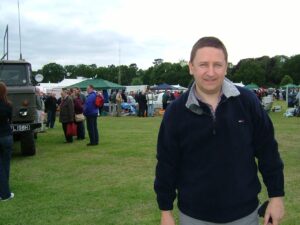
In 1990 I was just a naïve young lad, vulnerable to the seductive pull of RF of which I knew nothing. And there was nowhere more suffused with it than the local Radio Rally!
My ‘friend’ Ellis (GM4GZW) introduced me to my first hit. “Come to a radio rally near Glasgow (Ervine actually)” he said, “but beware that we’ll be there all day”. I wasn’t sure if I’d enjoy it or more likely get totally bored but…. YOU COULDN’T DRAG ME AWAY!
I’d discovered what I’d been missing in life: technology that I didn’t know existed; affordable stuff that I could buy and tinker with; rigs that I could drool over (but never be able to buy!). I was like a kid in a sweet shop. And that was it for me. One little taste and I was hooked.
Unfortunately, living in Edinburgh, the Rally calendar was pretty sparse. The few that took place were small / medium affairs and didn’t really satisfy my craving. I was informed that to get to the good stuff required more time and commitment. The first outing with ‘the boys’ was Blackpool. It was a good few hours drive but I was getting desperate for a fix.
It did not disappoint. They had everything! I bought my first ‘Wessy’ (Pye Westminster) and spent many hours fiddling and learning, buying the relevant crystals, tuning it up, putting in a preamp etc but eventually the high wore off and I needed something more.
Elvastan Castle is the stuff of legend. It was the best rally ever – so good in fact that four of us travelled from Edinburgh, spent the night at a Travelodge and the next day in Ham ecstasy. It took place in a field, three main tents (huge), and a number of other small ones. The flea market was never ending and everywhere you looked there were dealers pushing their wares. I think that was my last really long trip (~550 miles) but it shows how much of a junkie I had become
Ellis (GM4GZW) and Azeem (GM8KWQ) who were still making the trip from Scotland!
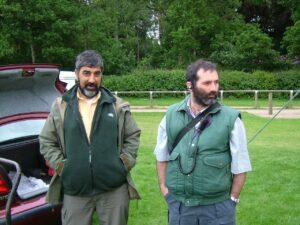
I moved to deepest Englandshire in 1992 and discovered that the Midlands is at the centre of all that is Rally related. Just about all of the major rallies are within 2 hours drive.A one off rally was the MARS rally at Alderbrook School in 2006. (See below right)
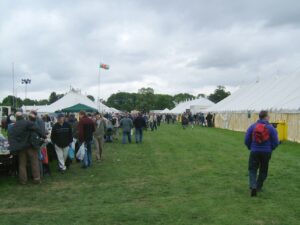
I could never understand why this was never repeated. It is just at the bottom of my road – I could have walked! But I didn’t. And it wasn’t bad!!
But then I discovered Wythall. It was many years before I joined the club but I was certainly a devoted attendee at the rallies. I remember the tent between the huts, the mud bath parking, the move to Woodrush school. And I remember the park and ride – I wonder which member was driving the minibus???
I always thought that this was a great rally. I have many mementoes sitting on my shelves. And it was so close too.
Wythall became one of my annual go-to events but there were a number of others. Some of them moved location over the years. The Leicester Amateur Radio Show was in Granby Halls in Leicester when I first sampled its delights. Granby Halls – what a dive –but an interesting rally. It moved to Donnington Park in 1998 and stayed for 10 years. It consisted of one huge hall with a few flea market bits outside. It reminded me a bit of the hall at the National Hamfest. Unfortunately after moving to Loughborough University in 2009 (which I missed) it disappeared into the mists of time.
Another rally which has seen a number of venues is the excellent Telford Rally. When I first went to this it was housed in a large sports hall. I will forever remember my trip there in 1997. I switched on radio 2 as I was heading along the M54 and was greeted with strange sombre church music, not at all what I expected. The cause as I’m sure many will remember was the announcement of the Death of Lady Diana Spencer. We had a moment of silence in the Rally hall, respected by all, and remembered by all who attended I am sure.
From the year 2000 it was then housed at RAF Cosford (for the next 5 years). It was great to be able to be distracted by the large jet fighters surrounding the vendors and provided an added dimension to the whole experience. I was sad to hear that they were leaving and I must say I did not like its new home at the Midlands Showground out near Shrewsbury. A poor venue and it seemed like a real hike to get there. Fortunately, the next year saw a move to ‘Enginuity’ (Ironbridge) which was a much more interesting place, and this excursion lasted 16 years. It again offered alternative entertainment to the actual rally (my addiction must be waning – I actually went round the museum once – but then the rally had probably finished). It recently moved again to Harper Adams University near Newport. This is a good venue and it is still one of the good rallies to attend.
The Rugby Rally has had a couple of moves over the years but it seems to have settled at Princethorpe College and is one of the best ‘outdoor’ rallies but don’t expect any of the major retailers. It’s like a smaller version of the Newbury rally – great for the rummagers amongst us.
As I’m getting older I find that much of the old technology that I used to drool over in my youth has become more available. And then some has become unavailable again when the collectors start to move in. I used to be able to pick up a BEEB (BBC micro computer) for a tenner at one time!
The National Vintage Communications Fair (or RetroTechUK as it now known) is a great place for nostalgia. Plenty of old gadgets – some even older than me! This has some ham gear but is much more diverse than most rallies.
The Milton Keynes Rally has moved around a bit but the venue now has a mixture of indoor and outdoor stalls. The indoor bit doesn’t thrill me much but there is plenty in the field. And after the rally it’s off to Bletchley Park for the wife and I. If you are a member of the RSGB you can download a voucher and get in for free so it’s a no brainer really. For those who want to see the vintage computing museum (well worth it) you will have to pay though. It really hits the spot for those of us who have tinkered with computers since the 80’s.
There are two pilgrimages for the rally junkie. One is the Dayton Hamvention in Ohio which is on my bucket list. The other is Friedrichshafen. Both are three day events and are massive. This is just one of the four main halls and there are talks and auctions and other special events. There was a steampunk gathering when I was there (2017) which I found particularly fun.
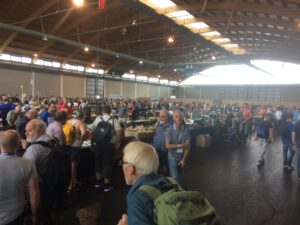
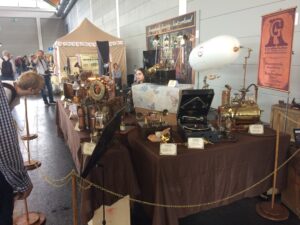
The Main Halls at the Famous Friedrichshafen Rally in Germany: David and Juliet (and probably Ian M0IDR) are in there somewhere!
And you never know who you will meet! It’s a small world! Jamie M0SDV with Juliet M6RSC (below right)

Lake Constance is beautiful. There are boat trips all around to see the sights, museums, Zeppelins in the sky, and it would be a fantastic place to just go for a holiday. The addition of a rally with every ham related item you could dream of (including many things you don’t see in the UK) makes it one of the essentials.

We were surprised to meet Jamie (2E0SDV) in Germany but I am never surprised to meet the only other ardent rally goer in the club. Ian (M0IDR) seems to be similarly afflicted to me. I am not surprised that his garage is rumoured to overflow with old radio gear. You just keep finding bargains!
I could go on and on (you already have I hear you say) about the various rallies but this ramble would not be complete if I didn’t mention the National Hamfest. This has been a fantastic addition to the rally calendar. It is huge, and has just the right mixture of dealers and junk. There is something there for everyone and its definitely one not to miss. It is unique in the UK in that it lasts 2 days. It takes me 1½ hours to drive there, but I still make the trip on both Friday and Saturday. Real hard core rallying on the Friday but I take Juliet, my wife (M6RSC), on Saturday for a gentler saunter. I was devastated to hear that this year’s excitement was not to be. But it will be back!
Unfortunately, many of the rallies that kept me satiated have ceased to be (including our own). There has always been some coming and going of rallies over the years but the pandemic really did for us. I hope that it recovers but I worry that the growth of the online auction sites has made life too easy for us gatherers of junk. It is much easier to obtain that special item that you have been looking for for years but I still prefer that rush when you find your long searched for treasure in a box under a table marked £1.
David G7IBO
The G7IBO Rally Curriculum Vitae in Full !
National Hamfest Newark, Elvastan Castle, Drayton Manor, Wythall, Rugby, Junction 28 Alfreton, Milton Keynes, Derby, Black Country, Leicester Amateur Radio Show, TelfordNEC (RSGB & Vintage radio) ? 90’s, Hack Green Secret Nuclear Bunker, Brighton and Hove, Newhaven Fort, Galashiels, Cockenzie & Port Seton, Blackpool, Wakefield, Lancaster University, Newbury, Kempton Park, Dunstable Downs (Luton) Andover, Harwell-Didcot, McMichael Rally Reading
Wherever next??!!
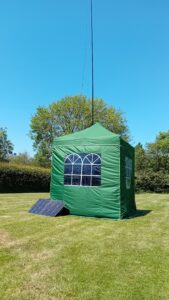
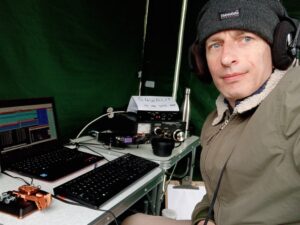
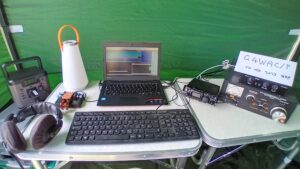
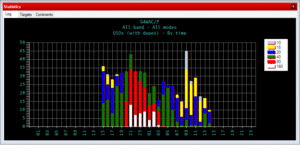
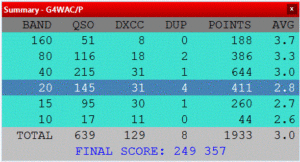 ee’s tally of points was impressive as shown in the final table submitted
ee’s tally of points was impressive as shown in the final table submitted 

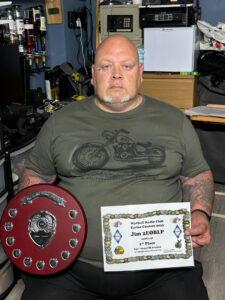
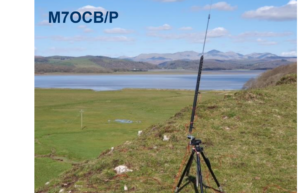
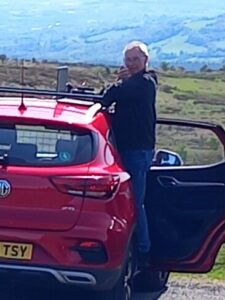
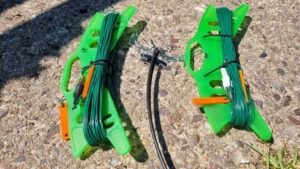 It’s a commonly used idea in NFD- to have a longer antenna overnight for the low bands and shorten it to make the antenna more efficient during the day on the higher bands. For QRP work my junk box phono connectors will hopefully suffice”
It’s a commonly used idea in NFD- to have a longer antenna overnight for the low bands and shorten it to make the antenna more efficient during the day on the higher bands. For QRP work my junk box phono connectors will hopefully suffice” 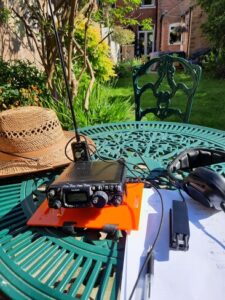
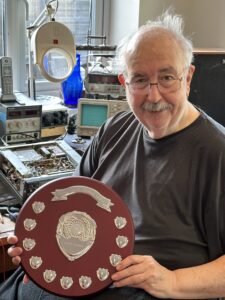
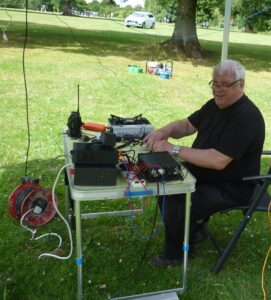
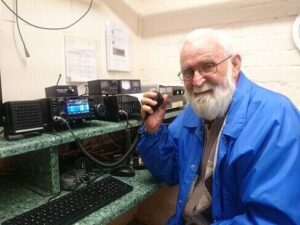
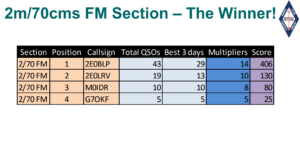
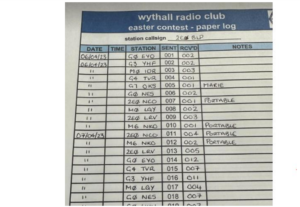
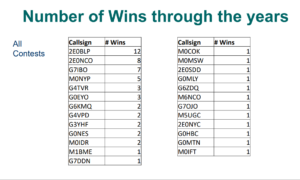
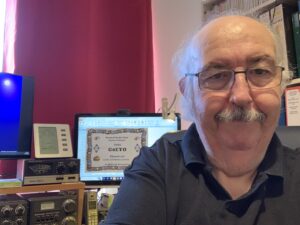
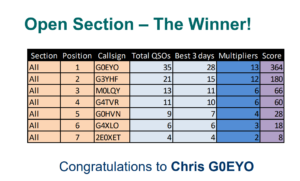
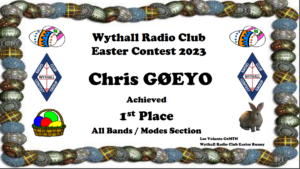
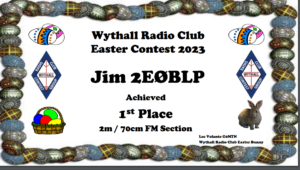
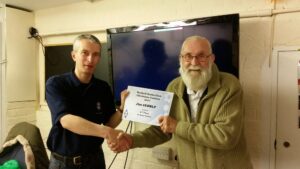 He helped out at all of the club ham rallies and was often to be found providing sustenance at club portable events such as field days, plug and play, special event stations and the summer BBQs. The club was able to show Jim how much we appreciated his enthusiasm for club events by naming a trophy after him last year. He was also very supportive through some difficult times at the club. Jim’s involvement with radio started in the CB days of the 1980’s and Jim always had the odd CB radio around although I don’t believe he used it very often.
He helped out at all of the club ham rallies and was often to be found providing sustenance at club portable events such as field days, plug and play, special event stations and the summer BBQs. The club was able to show Jim how much we appreciated his enthusiasm for club events by naming a trophy after him last year. He was also very supportive through some difficult times at the club. Jim’s involvement with radio started in the CB days of the 1980’s and Jim always had the odd CB radio around although I don’t believe he used it very often.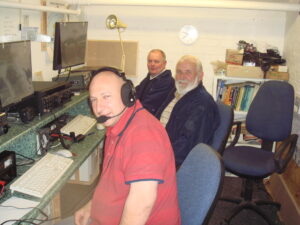
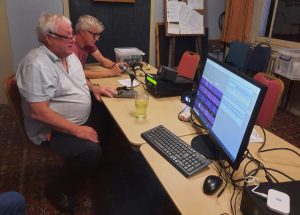
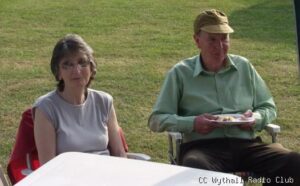
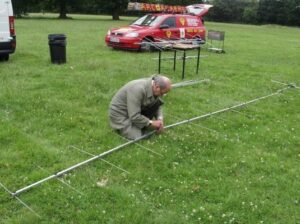 Antenna and QTH limitations meant he was never a huge signal from his home in Moseley, but he regularly entered club contests going back to the mid 90’s, and also took part in the RSGB Club Championship and UKAC events on 80m and 2m helping to boost the team scores.
Antenna and QTH limitations meant he was never a huge signal from his home in Moseley, but he regularly entered club contests going back to the mid 90’s, and also took part in the RSGB Club Championship and UKAC events on 80m and 2m helping to boost the team scores. 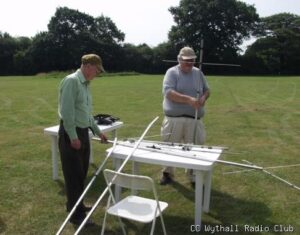
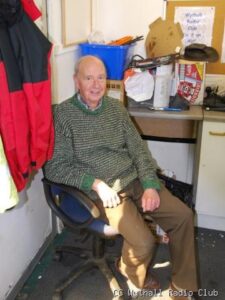 We understand that Vic’s funeral will be on 4th April at 3.30pm at Redditch crematorium.
We understand that Vic’s funeral will be on 4th April at 3.30pm at Redditch crematorium.





